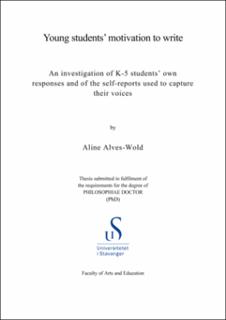| dc.description.abstract | The present project contributes knowledge of K-5 students’ motivation to write and foregrounds the students’ voices by examining students’ self-reports, like surveys, interviews, and alternative reports (e.g., drawings and written reflections). In this endeavor, three studies were carried out. First, a systematic literature review was conducted, and 56 empirical studies investigating K-5 classrooms (1996-2020) were synthesized. Given the massive data derived from this review and the different focus of the research questions investigated in each study, the results of the review are divided into two articles. The first focused on factors influencing the students’ writing motivation, and to inform the development of valid instruments, the second focused on the self-reports used in the reviewed studies. Thereafter, findings from study 2 revealed a need for investigating potential influences of scale format on young students’ responses. To test this hypothesis, a quasi-experimental study was conducted with Norwegian first and third graders, and findings are presented in a third article.
In study 1, nine factors influencing young students’ writing motivation were identified, and these are presented mnemonically as the ABCs of Writing Motivation, containing the following factors: [A] Appeal, [B] Beliefs, [C] Choice, [D] Difficulty, [E] Environment, [F] Feedback, [G] Goals, [H] Help, and [I] Instructor. Practice examples that support the implementation of these factors are also provided in article 1 in table form, which can be used by educators and researchers as a tool for planning writing lessons or interventions. Moreover, to convey transparently about what these factors entail, detailed examples of students’ utterances and responses, and of the contexts in which these factors were identified are also provided.
Study 2 investigated the types of writing tasks addressed in the self-reports used in the included studies, the motivation constructs assessed, and the emphasis given to the students’ voices. Results indicate that (a) the genre storytelling was used most often to operationalize writing in the studies, (b) although 32 motivation constructs were identified, attitude was the construct most often assessed through surveys and interviews, (c) students’ voices were weighted differently across studies, and (d) researchers often lacked sufficient rationale documentation for their choices/design of motivation measures.
Based on the widespread use of pictorial supports (e.g., animals, faces, geometrical figures) used in motivation measures with young students identified in study 2, yet lack of sufficient rationales for this design, study 3 worked to systematically compare pictorial supports. Specifically, two types of pictorial support were compared in a 5-point Likert scale: faces vs. circles. Quantitative results indicate that young students often skip motivation questions and avoid the extreme ends of the scale more often when face-scales are used.
In conclusion, given the inner nature of motivation, the present project shows that self-reports are a rich source of data for providing an insight into K-5 students’ perspectives on their motivations to write. However, to capture the students’ voices as accurately as possible, further attention is needed regarding the development of valid instruments for this purpose. First, the methodology used in the studies (i.e., quantitative, qualitative, or mixed methods) seems to be related to differences on the emergence of factors identified in study 1, indicating that open-ended questions may give students more room to express their unique views. Second, findings from study 2 indicate that future research assessing students’ writing motivation should (1) include more varied writing tasks in the assessments, which more realistically reflect the myriad of activities, tools, and genres that writing entails, and (2) report clearly whose voices are being heard (e.g., teachers, students, or researchers) and the suitability of this choice in relation to the study’s goals, design, and findings. Finally, despite the widespread use of face-scales in measures of motivation, findings from study 3 show that this type of scale has a biasing effect on students’ responses, and that circle-scales seem to be more appropriate for measuring young students’ interest and self-beliefs. However, more studies are needed to strengthen this finding and to contribute with further guidelines for the development of valid scales. | en_US |

